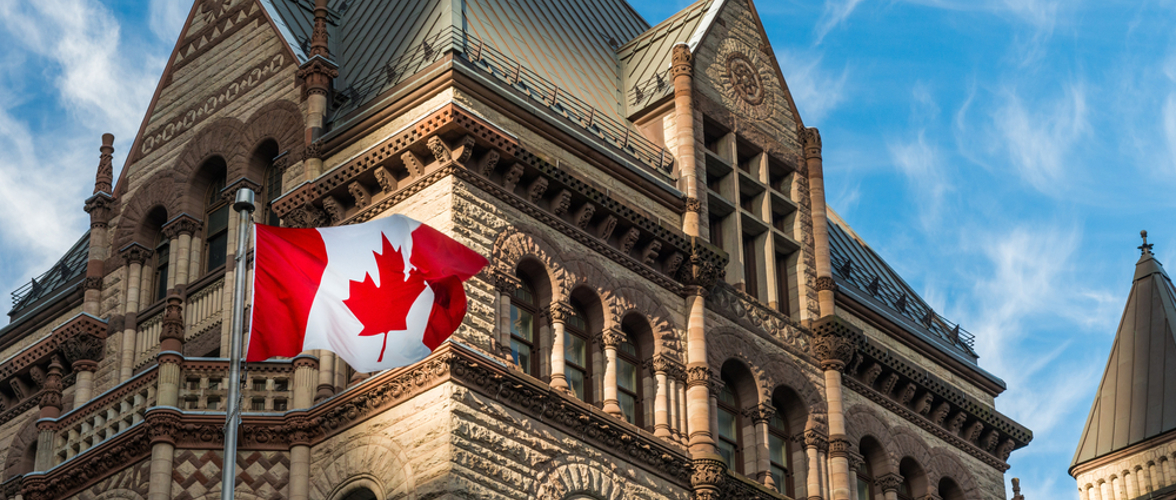Following strong GDP growth in the second half of 2020 through the first quarter of 2021 as the Canadian economy began to recover from the COVID-19 (coronavirus) pandemic, Canadian GDP fell 0.3% in the second quarter of 2021. Following three consecutive quarters of growth, this decline was driven by falling home resale activity and exports.
Nevertheless, GDP has still grown 1.1% over the first half of the year, driven by ongoing economic reopening efforts and continued improvements the labour market. Furthermore, new construction and renovations have driven growth in residential construction activity and increased housing investment, counterbalancing some losses from muted resale activity. Despite setbacks, ongoing vaccination efforts have given way to economic recovery while ongoing supply chain disruptions may continue to pressure trade activity.
Labour market
- 305,100 jobs were gained in the first half of 2021, driven by the continued easing of pandemic-related restrictions. With border restrictions on nonessential travel being lifted for fully vaccinated Americans on August 9, 2021, which bolstered employment for the accommodation and food services sector, 90,000 jobs were added in August 2021 alone.
- Three consecutive months of employment gains in some industries through August has brought employment in service-producing industries to prepandemic levels.
- With the easing of restrictive measures and widespread vaccine distribution, remote work has dwindled, with the percentage of workers working remotely declining to 24.0% in August 2021, down from its peak of 66.8% in April 2020.
- As employment has continued on a three-month trend of improvement through August 2021, the unemployment rate decreased 0.4 percentage points, reaching 7.1%.
- Sectors with the largest employment gains in the first half of 2021 include healthcare and social assistance; professional, scientific and technical services; accommodation and food service; and educational services. Meanwhile, employment in the manufacturing sector exhibited a sharp decline due to decreased exports of automobiles and related parts in addition to some ongoing labour shortages.

Recovered consumer spending
- Consumer spending has remained elevated through June 2021, with second-quarter 2021 spending exceeding prepandemic levels experienced in the second quarter of 2019. Overall, total household consumption expenditures in the first half of 2021 have increased 7.6% relative to the same time period in 2020, with year-over-year second quarter spending increasing 17.5%.
- Consumption trends indicate a shift from consumer goods to services, but also to more purchases of apparel as consumers go out again and return to some prepandemic activities.
- Retail sales rebounded in June 2021 due to increased spending on entertainment and hospitality as Canadians made trips away from their homes and increased travel.
- Despite a resurgence, travel spending is still remains lower than prepandemic levels, particularly due to some ongoing regulations in the first half of 2021.
- Spending growth was highest in regions that eased social distancing restrictions the earliest.
- According to data from the Royal Bank of Canada (RBC), consumer spending has remained elevated through August 2021, as measured by the volume of credit and debit card transactions.
Inflation
- Headline year-over-year inflation in August 2021 was 4.0%, the highest level since 2003, when inflation reached 4.2%.
- Gasoline and the homeowner’s replacement cost index were the largest contributors to year-over-year inflation in August.
- Notably, gasoline prices rose 32.5% during the first half of 2021, partially as a result of base effects and supply chain issues, including production stoppages due to extreme weather events in regions that export oil to Canada such as recent hurricanes.
- Gasoline prices are anticipated to moderate in the near term as production capacity resumes, although further disruptions to refineries could disrupt expectations.
- Year-over-year housing prices, measured by the homeowner’s replacement cost index, increased 14.3% in August 2021, which may drive more people to rent and place upward pressure on rental costs. This may continue to cause upward pressure on the shelter component of the consumer price index.
Construction activity across Canada
- Construction activity is often a leading indicator of business investment and consumer activity. Fluctuations in construction can significantly affect loan portfolios and investment strategies.
- Specifically for commercial lending clients, construction trends pose potential risks for loan exposures and probability of defaults, especially during economic downturns, such as during the coronavirus pandemic.
- Residential construction was hit the hardest by the pandemic-induced slowdown, as homebuilders backed off significantly. This primarily comes amid the stay-at-home orders for consumers and steep declines in consumer sentiment.
- Driven by rising per capita disposable income and falling interest rates in 2020, residential construction expanded during the pandemic, exceeding prepandemic levels and peaking in April 2021.
- While construction activity increased in the first quarter of 2021, fuelled by low interest rates and an expanding economy, total construction has decreased since April 2021. This decline has been primarily driven by falling in residential construction activity during the same period as demand has leveled off.
- Although residential construction has largely expanded during the pandemic, nonresidential construction has performed poorly over the past year, falling 10.5%. This trend is primarily a result of sluggish business activity and a slow reopening of the economy, as investors consider long-term expansion and growth prospects.

Construction in Ontario
- Relative to other provinces, Ontario was especially affected by the negative effects of the lockdown, especially given the temporary lockdown of the general auto industry and overall slower easing of restrictions in the province. Accordingly, the overall economic rebound has been more moderate in Ontario than in other provinces.
- Additionally, total construction has declined more rapidly in Ontario than in Canada. Between February 2021 and July 2021, total construction declined 3.9% in Ontario, while construction in Canada declined 2.6% during the same period.
- Despite declining overall construction activity in Ontario, nonresidential construction activity in Ontario has surged past precoronavirus levels, giving way to a potential rebound in the near future.
Financial markets
- S&P/TSX index has produced a price return of 18.7% in 2021, yet a return of 25.9% between September 15th, 2020 and September 15th, 2021.
- The Bank of Canada continues to taper bond purchases. It has also stated that it would bring net purchases of bonds to zero before raising its policy rate. The market has priced in an interest rate hike within the next 12 months.
- Canadian banks are expected to fare well in 2021 as provisions for loan losses are likely to decline and net interest margins are anticipated to rise.
Distribution of risk ratings
- 2019 risk ratings were close to normally distributed.
- 8% of Canadian industries rated as medium-high or greater risk.
- Risk in 2020 was concentrated at the higher end of the scale.
- 5% of Canadian industries rated as medium-high or greater risk.
- While risk in 2021 is expected to be more moderate, it is still elevated compared to 2019.
- 1% of Canadian industries rated as medium-high or greater risk.
- The risk outlook is expected to improve significantly by 2022, once the economy is fully reopened.
- 8% of Canadian industries rated as medium-high or greater risk.

Macro outlook:
As the Canadian economy exhibited three consecutive quarters of expansion prior to a decline in the second quarter of 2021, the emergence of new virus variants and infection surges has posed some turbulence and uncertainty for the outlook. Thus, expanding vaccine distribution and herd immunity will likely give way to a full recovery over the coming months, facilitated by easing restrictions.
While recent declines were driven by the emergence of a new wave of cases, the coming months are expected to be driven by the US-Canada border reopening and eased quarantine requirements for vaccinated Americans beginning August 9, 2021. Additionally, most jurisdictions in Canada have begun to approach final stages of reopening plans, lifting most restrictions on indoor locations, such as restaurants, event venues and retail stores. Driven by expanded tourism and domestic economic activity, economic improvement will likely be driven by recovery in consumer spending and business investment.
Sector highlights
- Accommodation and Food Services – Sector employment remains at 156,200 jobs below prepandemic levels as businesses remain pressured by ongoing regulations related to the coronavirus pandemic. Additionally, businesses have continued to contend with labour shortages for these low-wage positions and expanded federal and provincial support for unemployed workers. Consumer spending has remained elevated in service industries, including at food service establishments, standing to benefit industries such as Full-Service Restaurants. Additionally, with the easing of indoor dining and travel restrictions, this sector will likely benefit through the rest of 2021.
- Manufacturing – Manufacturing activity exhibited the sharpest employment decline as supply chain disruptions, shortages and falling export activity pressured hiring needs. Although government consumption expenditure and business investment in machinery and equipment both increased, this domestic growth was not enough to offset faltering international demand. Most notably, low production of motor vehicles and parts resulted in these substantial export declines, pressuring industries such as the Canadian Tire Manufacturing, Car and Automobile Manufacturing and the Canadian SUV and Light Truck Manufacturing
- Construction – Residential construction has remained a strong contributor to the Canadian economy since the third quarter of 2020, driving performance in industries such as the Canadian Homebuilders industry and the Canadian Apartment and Condominium Construction industry. Low mortgages and increased home equity lines of credit have driven spending on new houses and home renovations. However, home resale activities, as indicated by declines in home ownership transfer costs, have tapered in the second quarter of 2021, pressuring activity in related industries, such as the Canadian Real Estate Sales and Brokerage industry.







